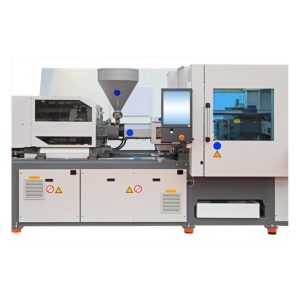Plastic Injection Molding Services
Our plastics manufacturing facility is proud to support the US injection molding industry by employing a local team of experienced and dedicated operators who run equipment ranging from 28 tons to 310 tons of clamping pressure, capable of injecting as much as 41 oz. of material per cycle. All are computer controlled, and give optimal efficiency in set-up, process control and monitoring. Our injection molding machines are designed for repeatability to help secure reduced labor costs and lower reject rates, saving you money.
- Plastic injection molding: 10 machines ranging from 28 to 310 ton clamping force.
- Shot Capacity: from less than a gram, up to 41 ounces per cycle.
- Custom Colors: custom plastic parts according to your specifications.
- Insert molding: which allows for other custom injection components such as threaded brass inserts to be completely integrated into the plastic molded part in cycle.
- Over molding: which uses different component materials and integrates them into a single part, much like what you might see on a toothbrush, where a soft elastomer material is molded onto a rigid handle.
Quality Control
Quality assurance is an integral part of any company in today’s competitive marketplace, and we take it very seriously. QA at Rex Plastics is a three-step process:
- A visual inspection is performed by our trained machine operators on every part that is made the moment it comes out of our machine using the parameters and critical dimensions set by you, our customer, to identify any rejects.
- The injection molded parts are then randomly inspected once again by our QA personnel at the machine once every hour, and any rejects are logged.
- Finally, the acceptable parts are boxed, counted, and moved to our quality control department, where they are randomly inspected once again, and the count is verified. The injection molded parts are then ready for shipment.
Rex Plastics is a plastic injection molding contract manufacturer, and is well known by other custom plastic molding companies as a quality molder. We are a molder with the full capability to work competently with our customers to transform their part design into a finished product, or to provide design assistance to make their concept a reality. We currently service the electronics, security, medical, communications, and consumer product industries, and pride ourselves on our precision, prompt product delivery, flexibility, and competitive prices.
Plastic Injection Molding Process
How does it work?
The plastic injection molding process has been around since 1872, and is a process of injecting molten material (typically metal or plastic) into a void or cavity that has been created in a particular shape.
In plastics, the raw material comes in pellet form, and can be purchased either pre-colored or in a natural state to be colored by the processor, or molder. The natural material is usually colored with a pellet concentrate that looks much like the base material (resin) but has been formulated with high concentrations of pigment. The color concentrate is typically added to the base resin at a ratio of 25/1, or 4%.
The resin is then gravity fed through a hopper into a heated barrel that contains a reciprocating screw that rotates, homogenizing the color and base resin together changing the color.
 Once the machine cycle is started, the plastic injection molding process begins. The mold closes and the material is injected out of the barrel under very high pressure, typically 15-30,000 psi, via a hydraulic pump through a hole in the mold (sprue hole), down a channel (runner), through the gate, and into the cavity.
Once the machine cycle is started, the plastic injection molding process begins. The mold closes and the material is injected out of the barrel under very high pressure, typically 15-30,000 psi, via a hydraulic pump through a hole in the mold (sprue hole), down a channel (runner), through the gate, and into the cavity.
The mold that houses the cavity has cooling channels drilled into it to transfer the heat away much like an engine block, and the material then cools and re-solidifies. Lastly, the mold (or die) opens and the part is ejected.
When the part is ejected out of the mold, the steel required to create any undercut design features of the part that prevent it from being removed straight out of the mold need to be dislodged before it can be ejected. This could be threads, holes, or simply a step in the part that traps steel and prevents a straight ejection.
Read our article to learn about how much plastic injection molding costs.
Biopolymers
Rex Plastics now offers biopolymers as an alternative option in renewable plastic production. We have invested our resources in the research and testing of these materials, and have assessed that biopolymer products offer a valuable eco-friendly alternative to conventional plastic in many circumstances.
For further information about Rex Plastics capabilities, phone 800-839-0366 or email.



